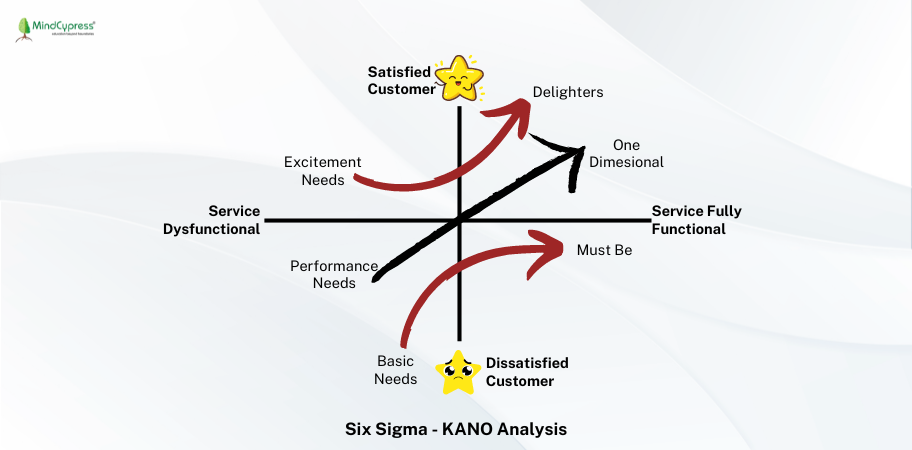Kano Model: What Is It and It’s Relation to Six Sigma
The Kano Model stands out as a powerful tool for understanding and prioritizing customer needs and preferences in quality management. Dr. Noriaki Kano developed it in the 1980s. It offers a structured approach to categorizing customer requirements and guiding product and service development efforts. This blog will delve into the basics of the Kano Model, exploring its key concepts and principles, and examining. It will also mention about its relevance to Six Sigma methodology.

The Essence of the Kano Model:
At its core, the Kano Model recognizes that not all customer requirements are created equal. Some features or attributes may be considered essential by customers, while others may be seen as merely satisfactory or even delightful. The model categorizes customer needs into five distinct categories:
Basic Needs (Must-Haves): These are essential requirements that customers expect as a minimum standard. Failure to meet these needs can lead to significant dissatisfaction for customers.
Performance Needs (One-Dimensional): These needs directly correlate with customer satisfaction. The more a product or service fulfills these requirements, the more satisfied customers will be.
Excitement Needs (Attractive): These are unexpected features or attributes that can pleasantly surprise customers and enhance their overall experience. While not essential, they can differentiate a product or service in the eyes of customers.
Indifferent Needs (Indifferent): These needs don’t enhance or detract from customer satisfaction. They are often taken for granted and do not significantly impact customer perception.
Reverse Needs (Must-Not-Haves): These are features or attributes that, if present, can actually decrease customer satisfaction. Eliminating these factors is crucial to avoiding dissatisfaction.
Kano Model and Six Sigma Relation
The principles of the Kano Model align closely with the goals and methodologies of Six Sigma, particularly in the areas of customer focus and continuous improvement. Here's how the it relates to Six Sigma:
Voice of the Customer (VOC) Analysis: Six Sigma emphasizes the importance of understanding customer needs and preferences through VOC analysis. The Kano Model provides a structured framework for categorizing and prioritizing customer requirements, helping organizations identify critical-to-quality characteristics and focus their improvement efforts accordingly.
Quality Function Deployment (QFD): QFD is a key tool in Six Sigma for translating customer needs into specific product or service features. Integrating Kano Model into QFD processes can help organizations accurately capture customer requirements and reflect in product design and development activities.
Designing for Delight: The Kano Model's focus on excitement needs aligns with the concept of designing for delight in Six Sigma. By identifying opportunities to exceed customer expectations and deliver unexpected value, organizations can differentiate themselves in the marketplace and foster customer loyalty.
Continuous Improvement: Both the Kano Model and Six Sigma promote a culture of continuous improvement. By regularly monitoring customer satisfaction and feedback, organizations can identify changing customer preferences and adapt their products and services accordingly, driving ongoing innovation and excellence.
Conclusion:
The Kano Model offers valuable insights into understanding and prioritizing customer needs and preferences. Hence, making it a valuable tool for organizations striving for customer-centricity and excellence. When integrated with Six Sigma methodologies, the Kano Model can enhance VOC analysis, guide product and service development efforts, and drive continuous improvement initiatives. By leveraging the principles of the Kano Model in conjunction with Six Sigma, organizations can better meet customer expectations, drive innovation, and achieve sustainable competitive advantage in today's dynamic marketplace.
If you are starting a career in Quality Management but have limited knowledge about the field, start learning with MindCypress. The top learning platform offers many professional courses for project managers and aspirants of quality management. You can choose from a variety of courses including Lean Six Sigma Green Belt Training, Lean Six Sigma Black Belt and Certified Manager of Quality.
